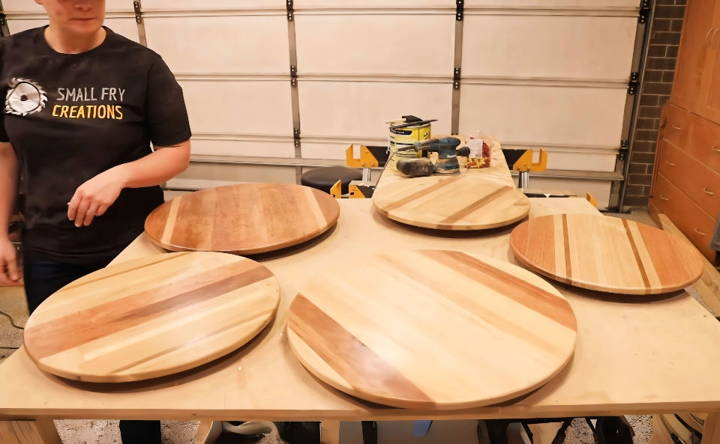Making a DIY lazy Susan was one of the simplest yet most useful projects I ever accomplished. I gathered a few basic materials: a round wooden board, a swivel bearing, and some screws. The tools I used were straightforward – a screwdriver and some sandpaper. It took me less than an hour to assemble, and the satisfaction of seeing it spin effortlessly made all the effort worth it.

This easy DIY lazy Susan became a game-changer in my kitchen. It not only saved space but also made reaching for condiments so much easier. Knowing I made it with my own hands added a personal touch. I encourage you to give it a try and see how useful it can be.
I'm helping with this DIY lazy Susan tutorial to get you started, and you'll find it very rewarding and practical.
Materials You'll Need and Why
Before diving into the process, let's discuss the materials required for this project:
- Scrap Wood: The beauty of this project is that it can breathe new life into those pieces of hardwood you have lying around. I chose hardwood for its durability and aesthetic appeal.
- Lazy Susan Hardware: You'll need this for the spinning functionality. Ensure you select a size appropriate for your project. I went for a hardware size that supported up to 600mm diameter tops.
- Glue: A water-resistant wood glue is essential, as you never know how the finished product will be used. Durability is key!
- Clamps: For holding the wood pieces securely while the glue dries.
- Router or Jigsaw: To cut the circular shape of the Lazy Susan. I used a router for a smoother cut.
- Drill and Screws: For attaching the hardware to the wood.
- Sandpaper and Finish: For smoothing the wood surface and adding a protective coating.
Step by Step Instructions
Learn how to effortlessly make a DIY lazy susan with our easy-to-follow step-by-step instructions. Perfect for adding convenience to your home!
Step 1: Preparing the Wood
The first step is to prepare your wood. If you're using scrap wood, you'll likely need to trim off any rough edges or unwanted parts. I set aside some time to sort through my wood pieces, cutting them into random widths but ensuring they were straight and clean.
Step 2: Assembling the Panels
Once I had my pieces ready, I started gluing them together to form panels. This part can be a bit tricky, as you want to align everything nicely. I glued the panels in two sections to manage the size better and to make it easier to run through a thickness planer later on. Remember, applying water-resistant glue will make your Lazy Susan more durable against spills.
Step 3: Shaping the Circles
After the glue dried and I planed the panels to an even thickness, it was time to cut them into circles. Using a router and a circle cutting jig made this process straightforward. However, you can also use a jigsaw with a steady hand. Aim for a smooth, even cut to minimize sanding later.
Step 4: Sanding and Finishing
Once I had my circular panels cut out, I smoothed the edges and surfaces with sandpaper, starting with a coarser grit and moving to a finer one. After sanding, I applied a satin clear coat as my finish. This not only enhanced the wood's natural beauty but also added a layer of protection.
Step 5: Attaching the Hardware
This segment is crucial for the Lazy Susan's functionality. First, mount the hardware on the bottom piece, making sure it's centered. You'll need to drill an access hole for the screws to attach the top part. Be meticulous with your measurements to ensure that the top spins smoothly when assembled. I learned that making a template for drilling the screw holes was a game changer for accuracy.
Tips for Success
- Take It Slow: Don't rush the process. Taking your time, especially with cutting and assembling, pays off in the quality of the final product.
- Measure Twice, Cut Once: This old adage is invaluable. Double-check your measurements before making any cuts to avoid mistakes.
- Experiment with Designs: Feel free to get creative with the pattern and type of wood you use. The varied textures and colors can make a unique, versatile piece.
Customization Ideas for Your DIY Lazy Susan
Building a DIY lazy Susan is not just about functionality; it's also an opportunity to express your creativity and add a personal touch to your home. Here are some customization ideas that can make your lazy Susan uniquely yours:
- Choose Your Theme: Think about the overall theme of the room where your lazy Susan will be placed. Is it rustic, modern, or perhaps eclectic? Select a design that complements the room's decor. For a rustic look, consider using reclaimed wood and a simple varnish. For a modern touch, sleek materials like acrylic or metal can be used.
- Paint It Pretty: A coat of paint can transform your lazy Susan into a statement piece. Use stencils to add patterns or hand-paint designs that reflect your personality. Chalkboard paint is also a great option for those who love to change things up, allowing you to write messages or label items on the lazy Susan.
- Decoupage Delight: Decoupage is a fantastic way to add intricate designs without needing advanced artistic skills. Cut out images or patterns from paper or fabric and adhere them to your lazy Susan with decoupage glue. Once dry, apply a clear sealant for a durable finish.
- Add Some Texture: Incorporate different textures to make your lazy Susan stand out. Attach tiles, pebbles, or even bottle caps to make a mosaic pattern. Not only does this add visual interest, but it also provides a tactile element.
- Functional Add-ons: Consider adding features that increase the utility of your lazy Susan. Hooks on the underside can hold kitchen utensils, while compartments or dividers can help organize spices, condiments, or craft supplies.
- Light It Up: For those who enjoy a bit of tech in their DIY projects, installing LED lights underneath the lazy Susan can provide ambient lighting and make it easier to find items in dimly lit areas.
- Personalized Engravings: If you have access to a wood-burning tool or laser engraver, adding a personalized message or your family name can make your lazy Susan a cherished item for years to come.
The key to a successful DIY project is to have fun and let your creativity shine. These ideas are just a starting point; feel free to mix and match or come up with your own unique twists.

Advanced Techniques for Your DIY Lazy Susan
When you're ready to take your DIY lazy Susan to the next level, advanced techniques can add both functionality and beauty. Here's how you can elevate your project:
- Incorporate Inlay Work: Inlaying is a method where you insert pieces of contrasting materials into depressions made in the base material. You can use different woods, metals, or even mother-of-pearl for a stunning effect. Start by designing a simple pattern and gradually move to more intricate designs as you gain confidence.
- Experiment with Joinery: If you're skilled with woodworking tools, try using dovetail or mortise-and-tenon joints for assembling your lazy Susan. These joints not only enhance the appearance but also increase the durability of your creation.
- Add a Motorized Base: For an extra touch of convenience, consider adding a motorized base to your lazy Susan. This can be particularly useful for larger units or when you want to showcase items like model cars or cakes. Use a small battery-powered motor and ensure it has a speed control for the best results.
- Integrate LED Lighting: Installing LED strips underneath the lazy Susan can make a beautiful ambiance and highlight the items on it. Choose from a range of colors and patterns to match the mood or decor of your room.
- Use High-Quality Finishes: Protect your lazy Susan and give it a professional look with high-quality finishes. Polyurethane or epoxy resin can provide a durable and glossy surface that's easy to clean and maintain.
- Try 3D Carving: If you have access to a CNC machine, you can carve intricate 3D patterns or images into the wood. This technique allows for precision and complexity that would be difficult to achieve by hand.
Use these advanced techniques to make your DIY lazy Susan both practical and artistic. Always prioritize safety, and seek tutorials or classes to enhance your skills.
Troubleshooting Common Issues with Your DIY Lazy Susan
When crafting a DIY lazy Susan, you might encounter a few hiccups along the way. Here's how to troubleshoot some of the most common issues:
The Lazy Susan is Wobbly
- Solution: Check the base and top plates to ensure they are perfectly flat and parallel to each other. If they're not, adjust them until they are. Also, verify that the central pivot is securely fastened and centered.
The Rotation is Stiff or Noisy
- Solution: This can be due to dirt accumulation or wear and tear on the bearings. Clean any debris from the bearing area and apply a lubricant designed for bearings. If the problem persists, consider replacing the bearings.
Difficulty in Turning
- Solution: Make sure there's nothing obstructing the path of the lazy Susan. If it's still hard to turn, the issue might be with the bearing mechanism. It may need cleaning or, if it's damaged, replacing.
Misalignment of the Turntable
- Solution: Misalignment can cause uneven rotation. To fix this, loosen the screws holding the turntable in place, adjust until aligned, then retighten the screws. Use a level to ensure it's flat.
Scratches or Dents on the Surface
- Solution: For scratches, you can use a wood filler or putty that matches the color of your lazy Susan. Sand the area after the filler dries. For dents, try using a damp cloth and an iron to steam the wood and raise the dent.
The Lazy Susan Doesn't Fit in the Cabinet
- Solution: Measure the cabinet space and the lazy Susan carefully. If it's too large, you may need to trim the edges of the lazy Susan to fit. Always measure twice before cutting.
By addressing these common issues, you can ensure your DIY lazy Susan operates smoothly and looks great.
FAQs About DIY Lazy Susan
Discover answers to faqs about DIY lazy susan projects, including materials, construction tips, and expert advice, in this comprehensive guide.
A Lazy Susan is a rotating tray, often circular, that sits on a table or countertop to easily share items among people. It’s commonly used in kitchens to access spices, condiments, or other small items without reaching across the table.
To decide on the size, measure the space where you plan to use the Lazy Susan. If it’s for a cabinet, measure the interior dimensions. For a table, consider the surface area. There’s no standard size; it should fit your space and needs.
Draw straight lines diagonally from corner to corner on one board. The point where the lines intersect is the center. This is crucial for aligning the top and bottom boards to ensure smooth rotation without wobbling.
Yes, you can make a simple Lazy Susan using basic materials like cake pans and marbles. Place marbles in one pan and set the other on top. This makeshift Lazy Susan can spin freely and is a quick, low-cost solution.
To install the bearing, first, ensure your boards are cut to the desired size and shape. Center the bearing on the bottom board using the center mark you made earlier. Secure the bearing with screws, then attach the top board to the other side of the bearing. Make sure the top board is centered and spins freely. If you're using a pre-made bearing, follow the manufacturer's instructions for installation.
The Conclusion of My Journey
By following these steps, you'll realize how simple it is to make something functional with minimal materials. Go ahead and start your DIY lazy Susan project today; you'll not only be saving money but also adding a personal accomplishment to your home.













